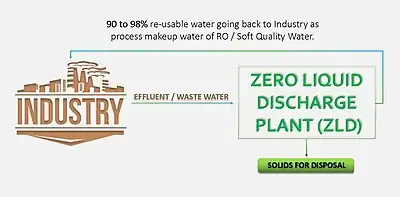Zero liquid discharge
Zero Liquid Discharge (ZLD) is a water treatment process designed to remove liquid waste from a system. The focus of ZLD is to reduce wastewater economically and produce clean water that is suitable for reuse (e.g. irrigation). ZLD systems employ advanced wastewater/desalination treatment technologies to purify and recycle virtually all of the wastewater produced.[1]


ZLD technologies also help plants meet discharge and water reuse requirements, enabling businesses to:
- meet stringent government discharge regulations
- reach higher water recovery (%)
- treat and recover valuable materials from the wastewater streams, such as potassium sulfate, caustic soda, sodium sulfate, lithium and gypsum
The conventional way to reach ZLD is with thermal technologies including evaporators (multi stage flash (MSF)), multi effect distillation (MED), mechanical vapor compression (MVC), crystallization, and condensate recovery. ZLD plants produce solid waste.
ZLD discharge system overview
ZLD technology includes pre-treatment and evaporation of the industrial effluent until the dissolved solids precipitate as crystals. These crystals are removed and dewatered with a filter press or a centrifuge. The water vapor from evaporation is condensed and returned to the process.
In the last few decades, there has been an effort from the water treatment industry to revolutionize the high water recovery and ZLD technologies.[2] This has led to processes like electrodialysis (ED/EDR), forward osmosis (FO) and membrane distillation (MD). A quick overview and comparison can be seen in the following table:[3][4][5]
- ED/EDR SEC depends on the salinity of the feed as higher salinities require higher SECs
- FO SEC depends on the Draw Solution and the Regeneration Method. Most papers assume the use of thermolytic salts and their regeneration at a 60°C temperature. 90% of the thermal energy needed can be acquired by waste heat if it's available
- MD SEC depends on the configuration. Most common MD configuration in the studies is Direct Contact MD (DCMD) due to its simplicity. 90% of the thermal energy needed can be acquired by waste heat if it's available and finally
- the total electrical equivalent was taken using the following, Total El. Equivalent = El. Energy + 0.45 x Thermal Energy due to modern power plant efficiency (according to relevant paper).
| Brine Treatment Technology | Electrical Energy (KWh/m3) | Thermal Energy (kWh/m3) | Total El. Equivalent (kWh/m3) | Typical Size (m3/d) | Investment ($/m3/d) | max TDS (mg/L) |
| MSF | 3.68 | 77.5 | 38.56 | <75,000 | 1,800 | 250,000 |
| MED | 2.22 | 69.52 | 33.50 | <28,000 | 1,375 | 250,000 |
| MVC | 14.86 | 0 | 14.86 | <3,000 | 1,750 | 250,000 |
| ED/EDR | 6.73 | 0 | 6.73 | / | / | 150,000 |
| FO | 0.475 | 65.4 | 29.91 | / | / | 200,000 |
| MD | 2.03 | 100.85 | 47.41 | / | / | 250,000 |
Configuration
Despite the variable sources of a wastewater stream, a ZLD system is generally comprised by two steps which are:
- Pre-Concentration; Pre-concentrating the brine is usually achieved with membrane brine concentrators or electrodialysis (ED). These technologies concentrate the stream to a high salinity and are able to recover up to 60–80% of the water.
- Evaporation/Crystallization; The next step with thermal processes or evaporation, evaporates all the leftover water, collect it, and drives it for reuse. The waste that is left behind then goes to a crystallizer which boils all the water until all the impurities crystallize and are filtered out as a solid.
See also
- Effluent guidelines (US wastewater regulations)
- Effluent limitation
References
- Panagopoulos, Argyris; Haralambous, Katherine-Joanne; Loizidou, Maria (2019-11-25). "Desalination brine disposal methods and treatment technologies – A review". Science of the Total Environment. 693: 133545. Bibcode:2019ScTEn.693m3545P. doi:10.1016/j.scitotenv.2019.07.351. ISSN 0048-9697. PMID 31374511. S2CID 199387639.
- Tong, Tiezheng; Elimelech, Menachem (2016-06-22). "The Global Rise of Zero Liquid Discharge for Wastewater Management: Drivers, Technologies, and Future Directions". Environmental Science & Technology. 50 (13): 6846–6855. Bibcode:2016EnST...50.6846T. doi:10.1021/acs.est.6b01000. ISSN 0013-936X. PMID 27275867.
- "Akvazen – Zero Liquid Discharge ZLD system" (PDF). www.wafindia.com/akvazen. Retrieved 2019-09-26.
- "Zero Liquid Discharge – ZLD". www.lenntech.com. Retrieved 2018-10-11.
- Charisiadis, Christos (2018-10-11). "ZLD Lenntech Booklet" (PDF). Lenntech.